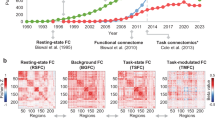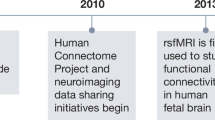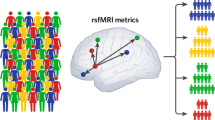Abstract
Functional magnetic resonance imaging (fMRI) is a central tool for investigating human brain function, organization and disease. Here, we show that fMRI-based estimates of functional brain connectivity artifactually inflate at spatially heterogeneous rates during resting-state and task-based scans. This produces false positive connection strength changes and spatial distortion of brain connectivity maps. We demonstrate that this artefact is driven by temporal inflation of the non-neuronal, systemic low-frequency oscillation (sLFO) blood flow signal during fMRI scanning and is not addressed by standard denoising procedures. We provide evidence that sLFO inflation reflects perturbations in cerebral blood flow by respiration and heart rate changes that accompany diminishing arousal during scanning, although the mechanisms of this pathway are uncertain. Finally, we show that adding a specialized sLFO denoising procedure to fMRI processing pipelines mitigates the artifactual inflation of functional connectivity, enhancing the validity and within-scan reliability of fMRI findings.
This is a preview of subscription content, access via your institution
Access options
Access Nature and 54 other Nature Portfolio journals
Get Nature+, our best-value online-access subscription
$32.99 / 30 days
cancel any time
Subscribe to this journal
Receive 12 digital issues and online access to articles
$119.00 per year
only $9.92 per issue
Buy this article
- Purchase on SpringerLink
- Instant access to full article PDF
Prices may be subject to local taxes which are calculated during checkout








Similar content being viewed by others
Data availability
The HCP dataset is publicly available on the open access Connectome database (https://db.humanconnectome.org/app/template/Login.vm), which can be accessed after signing a data use agreement. The PSU (https://openneuro.org/datasets/ds003768/versions/1.0.9) and YMRRC (https://openneuro.org/datasets/ds003673/versions/2.0.1) datasets are publicly available on the OpenNeuro repository. The MIC dataset is available upon reasonable request to the corresponding author.
Code availability
The code for assessing the presence of brain-wide FC inflation in an fMRI dataset is publicly available at https://github.com/ckorponay/Connectivity-Inflation/blob/main/FC_Inflation_Evaluator.m. The code and instructions for performing RIPTiDe denoising using the rapidtide package are publicly available at https://rapidtide.readthedocs.io/en/latest/usage_rapidtide.html#removing-low-frequency-physiological-noise-from-fmri-data.
References
Murphy, K., Birn, R. M. & Bandettini, P. A. Resting-state fMRI confounds and cleanup. Neuroimage 80, 349–359 (2013).
Glover, G. H., Li, T. Q. & Ress, D. Image‐based method for retrospective correction of physiological motion effects in fMRI: RETROICOR. Magn. Reson. Med. 44, 162–167 (2000).
Tong, Y., Hocke, L. M. & Frederick, B. B. Low frequency systemic hemodynamic ‘noise’ in resting state BOLD fMRI: characteristics, causes, implications, mitigation strategies, and applications. Front. Neurosci. 13, 787 (2019).
Power, J. D., Schlaggar, B. L. & Petersen, S. E. Recent progress and outstanding issues in motion correction in resting state fMRI. Neuroimage 105, 536–551 (2015).
Johnstone, T. et al. Motion correction and the use of motion covariates in multiple‐subject fMRI analysis. Hum. Brain Mapp. 27, 779–788 (2006).
Janes, A. C., Peechatka, A. L., Frederick, B. B. & Kaiser, R. H. Dynamic functioning of transient resting‐state coactivation networks in the Human Connectome Project. Hum. Brain Mapp. 41, 373–387 (2020).
Salimi-Khorshidi, G. et al. Automatic denoising of functional MRI data: combining independent component analysis and hierarchical fusion of classifiers. Neuroimage 90, 449–468 (2014).
Gu, Y., Sainburg, L. E., Han, F. & Liu, X. Simultaneous EEG and functional MRI data during rest and sleep from humans. Data Brief 48, 109059 (2023).
Esteban, O. et al. fMRIPrep: a robust preprocessing pipeline for functional MRI. Nat. Methods 16, 111–116 (2019).
Marek, S. et al. Reproducible brain-wide association studies require thousands of individuals. Nature 603, 654–660 (2022).
Bandettini, P. A. Lost in transformation: fMRI power is diminished by unknown variability in methods and people. Aperture Neuro https://doi.org/10.52294/725139d7-0b8a-49dc-a81d-ba2ca64ff6d9 (2022).
Keilholz, S., Pan, W., Billings, J., Nezafati, M. & Shakil, S. Noise and non-neuronal contributions to the BOLD signal. Applications to and insights from animal studies. Neuroimage 154, 267–281 (2017).
Poldrack, R. A. Precision neuroscience: dense sampling of individual brains. Neuron 95, 727–729 (2017).
Gordon, E. M. et al. Precision functional mapping of individual human brains. Neuron 95, 791–807 (2017).
Noble, S., Scheinost, D. & Constable, R. T. A decade of test–retest reliability of functional connectivity: a systematic review and meta-analysis. Neuroimage 203, 116157 (2019).
Noble, S., Scheinost, D. & Constable, R. T. A guide to the measurement and interpretation of fMRI test–retest reliability. Curr. Opin. Behav. Sci. 40, 27–32 (2021).
Janes, A. C., Krantz, N. L., Nickerson, L. D., Frederick, B. B. & Lukas, S. E. Craving and cue reactivity in nicotine-dependent tobacco smokers is associated with different insula networks. Biol. Psychiatry Cogn. Neurosci. Neuroimaging 5, 76–83 (2020).
Van Essen, D. C. et al. The WU-Minn Human Connectome Project: an overview. Neuroimage 80, 62–79 (2013).
Glasser, M. F. et al. The Human Connectome Project’s neuroimaging approach. Nat. Neurosci. 19, 1175–1187 (2016).
Korponay, C., Stein, E. A. & Ross, T. J. Misconfigured striatal connectivity profiles in smokers. Neuropsychopharmacology 47, 2081–2089 (2022).
Faillenot, I., Heckemann, R. A., Frot, M. & Hammers, A. Macroanatomy and 3D probabilistic atlas of the human insula. Neuroimage 150, 88–98 (2017).
Choi, E. Y., Yeo, B. T. & Buckner, R. L. The organization of the human striatum estimated by intrinsic functional connectivity. J. Neurophysiol. 108, 2242–2263 (2012).
Yeo, B. T. et al. The organization of the human cerebral cortex estimated by intrinsic functional connectivity. J. Neurophysiol. 106, 1125–1165 (2011).
Schaefer, A. et al. Local-global parcellation of the human cerebral cortex from intrinsic functional connectivity MRI. Cereb. Cortex 28, 3095–3114 (2018).
Engelmann, J. M. et al. Neural substrates of smoking cue reactivity: a meta-analysis of fMRI studies. Neuroimage 60, 252–262 (2012).
Glasser, M. F. et al. The minimal preprocessing pipelines for the Human Connectome Project. Neuroimage 80, 105–124 (2013).
Murphy, K. & Fox, M. D. Towards a consensus regarding global signal regression for resting state functional connectivity MRI. Neuroimage 154, 169–173 (2017).
Griffanti, L. et al. Hand classification of fMRI ICA noise components. Neuroimage 154, 188–205 (2017).
Erdoğan, S. B., Tong, Y., Hocke, L. M., Lindsey, K. P. & deB, F. B. Correcting for blood arrival time in global mean regression enhances functional connectivity analysis of resting state fMRI-BOLD signals. Front. Hum. Neurosci. 10, 311 (2016).
Aso, T., Urayama, S., Fukuyama, H. & Murai, T. Axial variation of deoxyhemoglobin density as a source of the low-frequency time lag structure in blood oxygenation level-dependent signals. PLoS ONE 14, e0222787 (2019).
Aso, T., Jiang, G., Urayama, S.-I. & Fukuyama, H. A resilient, non-neuronal source of the spatiotemporal lag structure detected by bold signal-based blood flow tracking. Front. Neurosci. 11, 256 (2017).
Tong, Y. et al. Evaluating the effects of systemic low frequency oscillations measured in the periphery on the independent component analysis results of resting state networks. Neuroimage 76, 202–215 (2013).
Wanger, T. J., Janes, A. C. & Frederick, B. B. Spatial variation of changes in test–retest reliability of functional connectivity after global signal regression: the effect of considering hemodynamic delay. Hum. Brain Mapp. 44, 668–678 (2023).
Frederick, B. D., Nickerson, L. D. & Tong, Y. Physiological denoising of BOLD fMRI data using Regressor Interpolation at Progressive Time Delays (RIPTiDe) processing of concurrent fMRI and near-infrared spectroscopy (NIRS). Neuroimage 60, 1913–1923 (2012).
Tong, Y. & Frederick, B. D. Time lag dependent multimodal processing of concurrent fMRI and near-infrared spectroscopy (NIRS) data suggests a global circulatory origin for low-frequency oscillation signals in human brain. Neuroimage 53, 553–564 (2010).
Hu, J.-Y. et al. A novel approach for assessing hypoperfusion in stroke using spatial independent component analysis of resting-state fMRI. Hum. Brain Mapp. 42, 5204–5216 (2021).
Gonzalez-Castillo, J., Fernandez, I. S., Handwerker, D. A. & Bandettini, P. A. Ultra-slow fMRI fluctuations in the fourth ventricle as a marker of drowsiness. Neuroimage 259, 119424 (2022).
Tanrıtanır, A. C. et al. The effect of scan length on the assessment of BOLD delay in ischemic stroke. Front. Neurol. 11, 381 (2020).
Pinto, J., Bright, M. G., Bulte, D. P. & Figueiredo, P. Cerebrovascular reactivity mapping without gas challenges: a methodological guide. Front. Physiol. 11, 608475 (2021).
Chi, N.-F. et al. Cerebral motor functional connectivity at the acute stage: an outcome predictor of ischemic stroke. Sci. Rep. 8, 16803 (2018).
Tagliazucchi, E. & Laufs, H. Decoding wakefulness levels from typical fMRI resting-state data reveals reliable drifts between wakefulness and sleep. Neuron 82, 695–708 (2014).
Liu, X. et al. Subcortical evidence for a contribution of arousal to fMRI studies of brain activity. Nat. Commun. 9, 395 (2018).
Bijsterbosch, J. et al. Investigations into within- and between-subject resting-state amplitude variations. Neuroimage 159, 57–69 (2017).
Shinar, Z., Akselrod, S., Dagan, Y. & Baharav, A. Autonomic changes during wake–sleep transition: a heart rate variability based approach. Auton. Neurosci. 130, 17–27 (2006).
Douglas, N. J., White, D. P., Pickett, C. K., Weil, J. V. & Zwillich, C. W. Respiration during sleep in normal man. Thorax 37, 840–844 (1982).
Lee, K. et al. Arousal impacts distributed hubs modulating the integration of brain functional connectivity. Neuroimage 258, 119364 (2022).
Joshi, S. & Gold, J. I. Pupil size as a window on neural substrates of cognition. Trends Cogn. Sci. 24, 466–480 (2020).
Ogoh, S. Interaction between the respiratory system and cerebral blood flow regulation. J. Appl. Physiol. 127, 1197–1205 (2019).
Allen, B., Jennings, J. R., Gianaros, P. J., Thayer, J. F. & Manuck, S. B. Resting high‐frequency heart rate variability is related to resting brain perfusion. Psychophysiology 52, 277–287 (2015).
Tong, Y., Hocke, L. M., Fan, X., Janes, A. C. & Frederick, B. D. Can apparent resting state connectivity arise from systemic fluctuations? Front. Hum. Neurosci. 9, 285 (2015).
Orban, C., Kong, R., Li, J., Chee, M. W. L. & Yeo, B. T. Time of day is associated with paradoxical reductions in global signal fluctuation and functional connectivity. PLoS Biol. 18, e3000602 (2020).
Richter, S., Marsalek, K., Glatz, C. & Gundel, A. Task‐dependent differences in subjective fatigue scores. J. Sleep Res. 14, 393–400 (2005).
Baumann, H., Baumann, R., Gurk, C. & Wolter, F. Electrophysiological studies of central nervous performance during monotony. Electroencephalogr. Clin. Neurophysiol. 24, 259–273 (1968).
Fukunaga, M. et al. Large-amplitude, spatially correlated fluctuations in BOLD fMRI signals during extended rest and early sleep stages. Magn. Reson. Imaging 24, 979–992 (2006).
Fultz, N. E. et al. Coupled electrophysiological, hemodynamic, and cerebrospinal fluid oscillations in human sleep. Science 366, 628–631 (2019).
Duyn, J. H., Ozbay, P. S., Chang, C. & Picchioni, D. Physiological changes in sleep that affect fMRI inference. Curr. Opin. Behav. Sci. 33, 42–50 (2020).
Aso, T., Uematsu, A. & Hayashi, T. Reliability of BOLD perfusion lag mapping depends on global signal amplitude. In Proc. Organization for Human Brain Mapping (OHBM) 2023 Annual Meeting Poster 528 (2023).
Bolt, T. et al. Widespread neural and autonomic system synchrony across the brain–body axis. Preprint at bioRxiv https://doi.org/10.1101/2023.01.19.524818 (2024).
Lynch, C. J. et al. Prevalent and sex-biased breathing patterns modify functional connectivity MRI in young adults. Nat. Comm. 11, 5290 (2020).
Bennett, H. C. & Kim, Y. Advances in studying whole mouse brain vasculature using high-resolution 3D light microscopy imaging. Neurophotonics 9, 021902 (2022).
Raz, A. et al. Ecological nuances in functional magnetic resonance imaging (fMRI): psychological stressors, posture, and hydrostatics. Neuroimage 25, 1–7 (2005).
Golestani, A. M., Kwinta, J. B., Strother, S. C., Khatamian, Y. B. & Chen, J. J. The association between cerebrovascular reactivity and resting-state fMRI functional connectivity in healthy adults: the influence of basal carbon dioxide. Neuroimage 132, 301–313 (2016).
Vijayakrishnan Nair, V. et al. Human CSF movement influenced by vascular low frequency oscillations and respiration. Front. Physiol. 13, 940140 (2022).
Fagerström, K. O. Measuring degree of physical dependence to tobacco smoking with reference to individualization of treatment. Addict. Behav. 3, 235–241 (1978).
Frederick, B. B., Salo, T., Drucker, D. M., Stout, J. N. rapidtide [Computer Software] (2016-2024). GitHub https://github.com/bbfrederick/rapidtide (2016).
Birn, R. M. et al. The influence of physiological noise correction on test–retest reliability of resting-state functional connectivity. Brain Connect. 4, 511–522 (2014).
Tong, Y., Yao, J., Chen, J. J. & Frederick, B. D. The resting-state fMRI arterial signal predicts differential blood transit time through the brain. J. Cereb. Blood Flow Metab. 39, 1148–1160 (2019).
Acknowledgements
This work was supported by grant no. 5R01DA039135-06 to A.C.J., the Intramural Research Program of the National Institutes of Health, the National Institute on Drug Abuse (to A.C.J.), and grant nos 1RF1MH130637-01 and 1R21AG070383-01 to B.B.F. The funders had no role in study design, data collection and analysis, decision to publish or preparation of the manuscript.
Author information
Authors and Affiliations
Contributions
C.K., A.C.J. and B.B.F. were responsible for study conceptualization, data collection, curation and analysis, and for writing, reviewing and editing the manuscript.
Corresponding author
Ethics declarations
Competing interests
The authors declare no competing interests.
Peer review
Peer review information
Nature Human Behaviour thanks Deborah Small, Wesley Vieira da Silva and the other anonymous reviewer(s) for their contribution to the peer review of this work. Peer reviewer reports are available.
Additional information
Publisher’s note Springer Nature remains neutral with regard to jurisdictional claims in published maps and institutional affiliations.
Supplementary information
Rights and permissions
Springer Nature or its licensor (e.g. a society or other partner) holds exclusive rights to this article under a publishing agreement with the author(s) or other rightsholder(s); author self-archiving of the accepted manuscript version of this article is solely governed by the terms of such publishing agreement and applicable law.
About this article
Cite this article
Korponay, C., Janes, A.C. & Frederick, B.B. Brain-wide functional connectivity artifactually inflates throughout functional magnetic resonance imaging scans. Nat Hum Behav 8, 1568–1580 (2024). https://doi.org/10.1038/s41562-024-01908-6
Received:
Accepted:
Published:
Issue date:
DOI: https://doi.org/10.1038/s41562-024-01908-6



